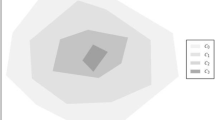Abstract
This paper presents a new extension of the elastic net for simultaneous gene selection and microarray classification. By introducing the proper data-driven weights to the penalty terms, the partly adaptive elastic net is proposed, which can encourage an adaptive grouping effect and reduce the influence of the wrong initial estimation. A fast-solving algorithm is also developed in the line of pathwise coordinate descent. Experiments performed on the two cancer data sets are provided to verify the obtained results.




Similar content being viewed by others
References
Dudoit S, Fridlyand J, Speed TP (2002) Comparison of discrimination methods for classification of tumors using gene expression data. J Am Stat Assoc 97(457):77–87
Golub T et al (1999) Molecular classification of cancer: class discovery and class prediction by gene expression monitoring. Science 286(5439):531–536
Guyon I, Weston J, Barnhill S, Vapnik V (2002) Gene selection for cancer classification using support vector machines. Mach Learn 46(1):389–422
Zhu J, Rosset S, Hastie T, Tibshirani R (2004) 1-norm support vector machines. Adv Neural Inform Process Syst 16(1):49–56
Cawley GC, Talbot NLC (2006) Gene selection in cancer classification using sparse logistic regression with Bayesian regularization. Bioinformatics 22(19):2438–2355
Cawley GC, Talbot NLC (2007) Preventing over-fitting during model selection via Bayesian regularisation of the hyper-parameters. J Mach Learn Res 8:841–861
Yuan M, Lin Y (2006) Model selection and estimation in regression with grouped variables. J R Stat Soc Ser B 68(1):49–67
Park M, Hastie T (2008) Penalized logistic regression for detecting gene interactions. Biostatistics 9:30–50
Zou H, Hastie T (2005) Regularization and variable selection via the elastic net. J R Stat Soc Ser B 67(2):301–320
Wang L, Zhu J, Zou H (2008) Hybrid huberized support vector machines for microarray classification and gene selection. Bioinformatics 24:412–419
Li J, Jia Y (2010) An improved elastic net for cancer classification and gene selection. Acta Automatica Sinica 36:976–981
Li J, Jia Y, Du J, Yu F (2009) Adaptive multi-class support vector machine for microarray classification and gene selection. ICROS-SICE international joint conference 2009. Fukuoka International Congress Center, Japan, pp 2658–2663
You M, Li GZ (2011) Feature selection for multi-class problems by using pairwise-class and all-class techniques. Int J General Syst 40(4):381–394
Li GZ, Meng HH, Yang MQ, Yang JY (2009) Combining support vector regression with feature selection for multivariate calibration. Neural Comput Appl 18:813–820
Li GZ, Yang J, Ye CZ, Geng D (2006) Degree prediction of malignancy in brain glioma using support vector machines. Comput Biol Med 36:315–325
Tibshirani R (1996) Regression shrinkage and selection via the lasso. J R Stat Soc Ser B 58:267–288
Zou H (2006) The adaptive lasso and its oracle properties. J Am Stat Assoc 101:418–1429
Zou H, Zhang HH (2009) On the adaptive elastic net with a diverging number of parameters. Ann Stat 37(4):1933–1751
Friedman J, Hastie T, Tibshirani R (2008) Regularization paths for generalized linear models via coordinate descent. Technical report, Department of Statistics, Standford University, USA
Friedman J, Hastie T, Höfling H, Tibshirani R (2007) Pathwise coordinate optimization. Ann Appl Stat 1(2):302–332
Segal M, Dahlquist K, Conklin B (2003) Regression approach for microarray data analysis. J Comput Biol 10:961–980
Efron B, Hastie T, Johnston I, Tibshirani R (2004) Least angle regression. Ann Stat 32:407–451
Rosset S, Zhu J (2007) Piecewise linear regularized solution paths. Ann Stat 35:1012–1030
Zheng C, Chong Y, wang H (2011) Gene selection using independent variable group analysis for tumor classification. Neural Comput Appl 20:161–170
Segal E, Friedman N, Koller D, Regev A (2004) A module map showing conditional activity of expression modules in cancer. Nature Genetics 36:1090–1098
de Souto MCP, Costa IG, Araujo DAS, Ludermir TB, Schliep A (2008) Clustering cancer gene expression data: a comparative study. BMC Bioinform 9:497
Acknowledgments
The authors thank to referees for insightful comments, which led to significant improvement of the paper. This work was supported by the NSFC (60850004, 11171094), and Foundation of Henan Educational Committee (2011B120005).
Author information
Authors and Affiliations
Corresponding author
Rights and permissions
About this article
Cite this article
Li, J., Jia, Y. & Zhao, Z. Partly adaptive elastic net and its application to microarray classification. Neural Comput & Applic 22, 1193–1200 (2013). https://doi.org/10.1007/s00521-012-0885-6
Received:
Accepted:
Published:
Issue Date:
DOI: https://doi.org/10.1007/s00521-012-0885-6




